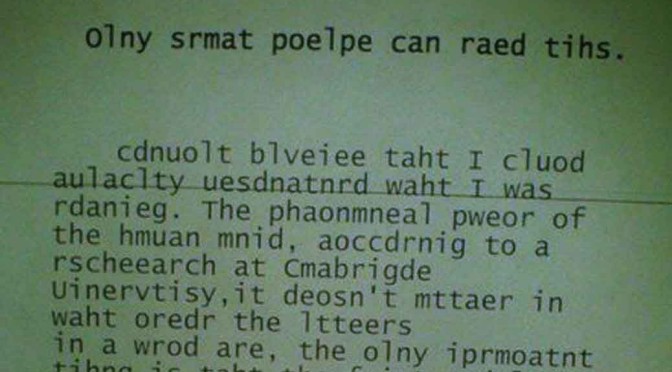By Anupum Pant
Background
Oh tell me you have never received this old chain mail that had the following paragraph attached in it, and warned you that if you did not forward it to 20 friends, something bad would happen. The passage –
Aoccdrnig to rscheearch at Cmabrigde uinervtisy, it deosn’t mttaer waht oredr the ltteers in a wrod are, the olny iprmoetnt tihng is taht the frist and lsat ltteres are at the rghit pclae. The rset can be a tatol mses and you can sitll raed it wouthit a porbelm. Tihs is bcuseae we do not raed ervey lteter by it slef but the wrod as a wlohe.
The paragraph contains a bunch of letters that are jumbled and you are still able to read it at a normal pace. The passage speaks for itself and says that according to a research study done at Cambridge university, it doesn’t matter in what order the letters in a word are; only the first and last letters need to be in the right place. According to it, everything in the middle can be messed up and you can still easily read it even when it clearly shouldn’t be making any sense.
Questions, Questions!
Certainly blows your mind. But if you start questioning the legitimacy of what the passage claims, you start finding a couple of unanswered questions…
1. It says, “a researcher at Cambridge”. I’d like to throw an open challenge to you – Find me the publication where “the researcher from Cambridge University” published this paragraph (or something similar).
Cambridge does have a Cognition and Brain Sciences Unit where researchers try to figure how brain processes language. But it is clear from this blog-post that people at Cambridge didn’t even know about the meme that had been circulating all over the internet. At the time when this meme started circulating, in Cambridge, no one was doing research in this area. The prof says:
To my knowledge, there’s no-one in Cambridge UK who is currently doing research on this topic. There may be people in Cambridge, MA, USA who are responsible for this research, but I don’t know of them.
However, in 1999, the effect was originally demonstrated in a letter – [here]
Let’s give it up for the internet trolls, the phenomenon is indeed, intriguing. The researcher tries to figure out the science behind it in the same blog-post. He finds that the effect is same with many other languages. However, it doesn’t seem to work with languages like Finnish and Hebrew.
2. Try reading this:
Bblaaesl pryleas pnmrrioefg srillaimy aeoulltsby dvrseee clbrpmaaoe tteenmrat.
If you need hints, it follows the same rule. The sentence has all the words with first and last letters in place. The letters in the middle are jumbled. According to “the researcher from Cambridge” you should be able to read it easily. Why can’t you? It follows the exactly same rules. Have I made my point?
Why does it work?
Believe it or not, the paragraph actually works. I could read it without any hiccups. At the same time, the one above, which follows the same rules is pretty difficult to read. So what makes the chain mail paragraph so readable? In simple words…
1. There are 69 words in the paragraph. Out of those 69 words, only 37 are jumbled. All the other 32 words are two or three lettered words, which can’t follow the rule. That clears up the structure of sentences.
2. Out of the 37 jumbled words. 12, if I counted correctly, are four letter words that can only have the middle letters swapped. Those are breeze to figure out. That leaves us with just 25 jumbled letters. Given your life-long experience with reading, you can easily predict those if you know most of the other words.
3. Most of these 5 or more lettered words (in 25) are at such places that they don’t even require reading. For instance, your brain can easily figure that “because” will come after “this is”. So it knows, “bcuseae” is actually “because”. Also, all of these 25 “big” words are easy and familiar ones.
4. The words have not been jumbled a lot. There are mostly letter swaps, like – porbelm. “Porbelm” has just 2 pair of letters swapped. All those words that have this are pretty easy to figure too. What if it was “pbelorm”? It gets tougher when the central letter is moved from its place. Isn’t it?
But the mission of the makers of the meme passage was to blow your minds in a way that you’d be forced to forward it to your friends. So, they put in easy jumbles.
Did you like this article?
Every day I send out a newsletter with an un-cut new article and exclusive content for readers. It’s basically my way of keeping in touch with you and letting you know what’s going on. Your information is protected and I never spam.
Subscribe from the sidebar to stay connected. Feel free to reply to these newsletters too…






